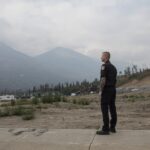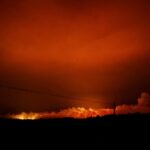As towering plumes of smoke darkened the northern Alberta sky last week, Tara Cardinal found herself making the split-second decision that would separate her from her family amid the chaos of a mandatory evacuation order. The rapidly advancing wildfire near Fort McMurray left the 42-year-old resident with minutes to gather essentials before fleeing her home of 15 years.
“I grabbed what I could—medications, important documents, and some clothes,” Cardinal told me during our phone interview yesterday. “The hardest part wasn’t leaving our possessions behind; it was watching my husband and children head in a different direction due to our transportation limitations.”
This devastating scenario has become all too familiar for many Albertans as the province faces what officials are calling an unusually aggressive early fire season. As of Monday morning, Alberta Wildfire reports 23 active wildfires across the northern region, with seven classified as out of control. The combined burn area has already exceeded 150,000 hectares—roughly twice the size of Calgary.
Cardinal’s family separation occurred when evacuation routes became congested, forcing emergency management officials to direct residents toward different safe zones. Her husband and two children headed south toward Edmonton, while Cardinal joined neighbors traveling east toward Saskatchewan.
“The communication networks were overwhelmed immediately,” explained Cardinal. “For nearly 18 hours, I had no idea if they had made it to safety. It was the longest night of my life.”
Alberta Premier Danielle Smith visited the emergency operations center in Fort McMurray yesterday, announcing additional resources for firefighting efforts and evacuee support. “We’ve deployed every available resource to combat these fires and support displaced residents,” Smith stated during the press conference. “Our priority remains getting families reunited and ensuring everyone has safe accommodation.”
Climate scientists have pointed to concerning patterns behind Alberta’s increasingly severe wildfire seasons. Dr. Melissa Thompson, atmospheric researcher at the University of Alberta, notes that rising temperatures and changing precipitation patterns have created ideal conditions for these extreme events.
“What we’re witnessing isn’t simply bad luck,” Thompson explained. “The data shows a clear correlation between climate change impacts and the increased frequency and intensity of wildfires across Western Canada. This year’s early start to fire season aligns with projections we’ve been warning about for years.”
For evacuees like Cardinal, the immediate concern remains family reunification and basic necessities. The Red Cross and provincial emergency services have established reception centers in Edmonton, Cold Lake, and several other communities where evacuees can register for support services including temporary housing, food vouchers, and mental health resources.
“The community response has been overwhelming,” Cardinal said, her voice breaking slightly. “Complete strangers have offered accommodation, clothing donations, and even helped me search for my family through social media groups.”
Provincial officials estimate that over 6,500 residents have been displaced by the current wildfires, with that number potentially rising as several communities remain under evacuation alert. Emergency Management Minister Mike Ellis has assured residents that financial assistance will be available for those impacted, with details of the support program expected later this week.
According to the latest update from Alberta Wildfire, favorable weather conditions may provide some relief in the coming days, with cooler temperatures and potential rainfall forecast for parts of the affected region. However, officials caution that the situation remains dynamic, with wind shifts potentially pushing flames in new directions with little warning.
For Cardinal, who has now located her family through evacuation registration systems, the focus shifts to an uncertain future. “We don’t know if our home is still standing or when we might be allowed to return,” she said. “But at least we’ll face whatever comes next together once we’re reunited.”
As Alberta communities rally to support thousands of displaced residents, the question remains: how will these increasingly frequent climate emergencies reshape northern communities, and what long-term solutions must we implement to protect vulnerable populations from this new reality?

























